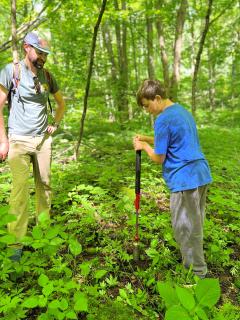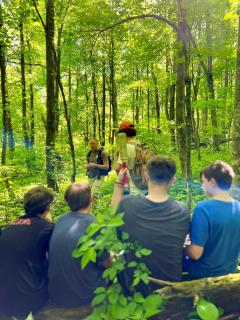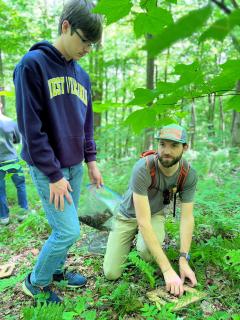West Virginia students get hands-on with science
WEST VIRGINIA—Two dozen eighth graders from Tucker County Middle School in West Virginia recently got hands-on with science through a field trip to the Fernow Experimental Forest. Guided by researchers from West Virginia University and the Forest Service’s Northern Research Station, the students learned about the legacy of acid rain and questions scientists are trying to answer regarding its lasting impact.
Part of a five-year project funded through the National Science Foundation, this trip is one component of a larger study looking at the long-term effects of nitrogen deposition upon eastern U.S. forests, especially relating to greenhouse emissions of carbon.
A component of the National Science Foundation-supported project focuses upon science education for rural communities. “Many people who live near the Fernow do not know what research is done here,” says Rau. “The grant that WVU obtained lets us bring eighth graders from nearby Tucker County Middle School to learn about the experiments taking place right in their own backyard while exploring careers in research.”
During the day-long fieldtrip, students implemented leaf decomposition bags to track break down of foliage on the forest floor, collected soil samples looking at carbon and nitrogen levels, and installed perforated PVC tubes used to measure root growth.
“Collaborating with West Virginia University on this study is rewarding,” reflects Rau. “We are answering important questions about the ways in which forests store carbon in the aftermath of acid rain while also getting young people excited about science. Seeing their faces light up with interest as they learned about the science happening right here makes it all worth it.”
The Clean Air Act, first passed in 1970 and expanded over ensuing decades, has significantly improved air quality. At Fernow, scientists are looking to understand how reduced nitrogen oxide levels, a key part of acid rain, are affecting forests.
“The Clean Air Acts were successful in lowering air pollution caused in part by nitrogen oxides,” explains Benjamin Rau, a research hydrologist with the Northern Research Station. “That’s why around 1990, Forest Service scientists at Fernow began a long-term study on forest nitrogen levels.”
For three decades, researchers at Fernow simulated acid rain by fertilizing a test watershed with ammonium sulfate—a nitrogen source. The experiment showed a consistent shift in the dominant tree species. Trees that depend upon a special type of fungi in their roots, called arbuscular mycorrhizal fungi, became more prevalent.
“Prior to acid rain, when nitrogen levels in forests were naturally occurring, trees sought out nitrogen by relying upon microbes and fungi in the soil to break down organic matter and release the element,” Rau says. “These microbes and fungi, while mining nitrogen from the soil, also release greenhouse gases such as carbon into the air.”
During the era of acid rain and subsequent simulated acid rain experiments, trees species shifted to those that use arbuscular mycorrhizal fungi. This type of fungi more easily absorbs nitrogen—of which there was bountiful amounts. “With nitrogen so readily available, trees grew larger, captured more carbon dioxide from the air, and stored more carbon in their fallen leaves on the forest floor, where they decomposed very slowly,” adds Rau.
The nitrogen fertilization experiment ended in 2020, so researchers are studying the forest’s response to natural nitrogen levels through this grant from the National Science Foundation's Long-Term Research in Environmental Biology program.
“Acid rain led to broad increases in the amount of carbon stored in wood and soils. I like to call this ‘bonus’ carbon, “says Edward Brzostek, associate professor of biology at West Virginia University. “With the success of the Clean Air Act, we don’t have nitrogen fertilizing our forests anymore, so our big question is whether the bonus carbon will stick around in the soil, or will it be lost as climate change continues?”
All this would not be possible without the crucial role played by Fernow Experimental Forest, according to Rau. “This project spearheaded by WVU is but one example of Forest Service R&D teaming up with partners to answer scientific questions that we could not answer without the facilities and long-term data available at Fernow.”



